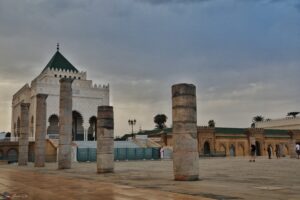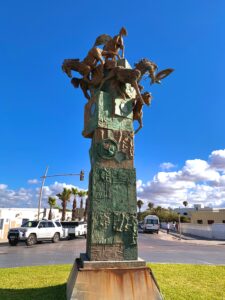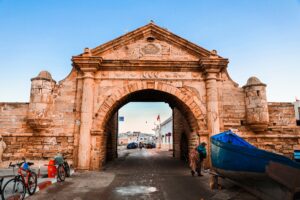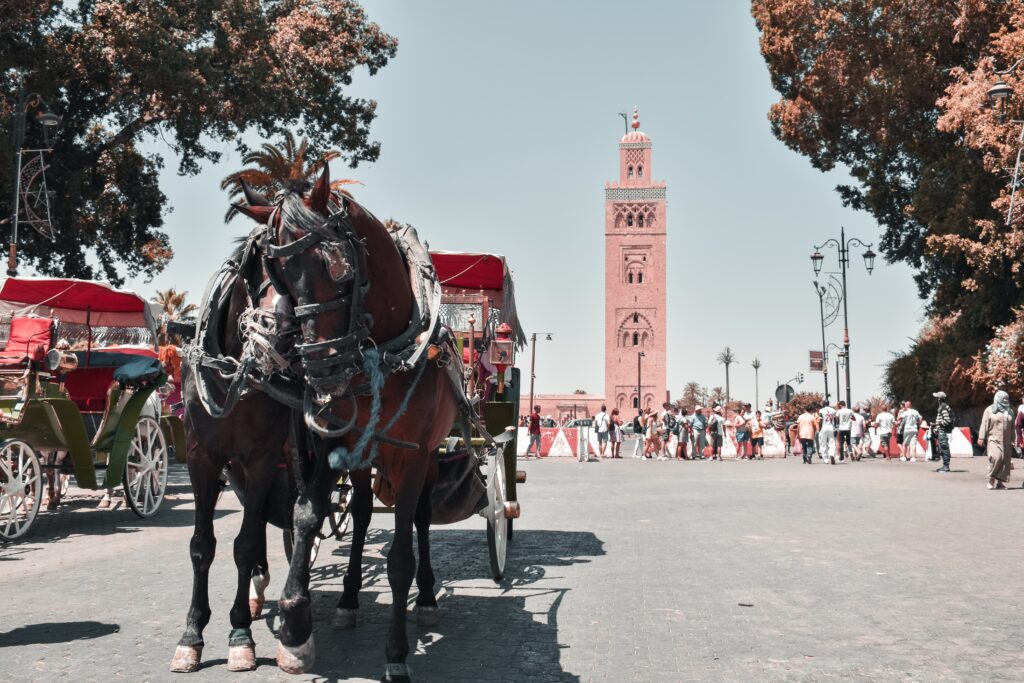
Marrakesh, a city that resonates with the echoes of centuries past, reveals one of its most treasured cultural landscapes—the Agdal. An oasis of historical splendor and natural beauty, the Agdal stands as a testament to the enduring legacy of Morocco’s cultural heritage. This introduction beckons you to embark on a journey through time, exploring the intricate tapestry of the Agdal’s past and present.
- A Living Legacy: In the heart of Marrakesh, the Agdal emerges as a living legacy, a landscape that has gracefully weathered the sands of time. Its roots reach deep into the annals of Moroccan history, where Berber and Islamic influences intertwine to create a cultural mosaic that has shaped the city’s identity.
- Architectural Grandeur: The Agdal is not merely a collection of gardens; it is a symphony of architectural grandeur. From the regal palaces built during the Almohad dynasty to the ornate pavilions and fortifications that dot the landscape, each structure tells a story of craftsmanship and cultural fusion, where form and function dance in harmony.
- Cultural Resilience: The Agdal, like Marrakesh itself, has endured the rise and fall of dynasties, witnessing the ebb and flow of cultural influences. It stands as a resilient guardian of tradition, a testament to the adaptability of Moroccan culture as it seamlessly integrates with the evolving currents of time.
- UNESCO’s Embrace: In 2011, the Agdal received the prestigious embrace of UNESCO, earning its place on the World Heritage list. This acknowledgment recognized not only the architectural magnificence but also the universal value of a cultural landscape where history and nature coalesce.
- A Cultural Retreat: Beyond its tangible structures, the Agdal has been a cultural retreat for rulers seeking solace amidst the beauty of Marrakesh. The gardens, water features, and open spaces invite reflection, creating a serene backdrop for ceremonial processions, religious observances, and communal celebrations.
- Environmental Symphony: At the core of the Agdal’s allure is its environmental symphony. Carefully designed irrigation systems, lush orchards, and the embrace of the Atlas Mountains contribute to a harmonious coexistence with nature. The Agdal is a testament to sustainable practices that nurture both the cultural and ecological facets of the landscape.
This exploration of the Agdal of Marrakesh beckons those who seek to unravel the layers of Morocco’s cultural heritage. It invites you to wander through the gardens, admire the architectural marvels, and immerse yourself in the rituals that echo through the centuries—a journey into a cultural landscape that continues to nurture the heritage of Marrakesh.
Section 1: Historical Roots of the Agdal:

Unveiling Centuries of Heritage
The Agdal of Marrakesh, a timeless jewel within Morocco’s cultural crown, derives its essence from a rich tapestry of historical roots that spans across centuries. This section peels back the layers of time, delving into the origins and evolutions that have shaped the Agdal into a testament to the enduring cultural legacy of Morocco.
- 1.1 Origins in the Almoravid Dynasty: The Agdal’s story begins in the 11th century during the reign of the Almoravid dynasty. Founded as a retreat for rulers, the initial purpose of the Agdal was rooted in practicality, serving as a vast garden oasis designed to provide respite amidst the arid landscapes of Marrakesh.
- 1.2 Berber and Islamic Fusion: As the centuries unfolded, the Agdal became a canvas where Berber and Islamic influences converged. The landscape, with its architectural elements and garden designs, reflects a harmonious fusion of indigenous traditions and Islamic aesthetics. The Agdal stands as a living testament to Morocco’s ability to weave cultural diversity into its historical narrative.
- 1.3 Dynastic Transformations: Through the Almohad and Merinid periods, the Agdal underwent transformative expansions and renovations. Each dynasty left an indelible mark on the landscape, introducing architectural elements that reflected the prevailing artistic and cultural trends of their era. The Agdal became a reflection of Morocco’s evolving dynastic history.
- 1.4 Saadian and Alaouite Contributions: The Saadian dynasty, known for its architectural prowess, further enriched the Agdal with palaces, pavilions, and intricate structures. The Alaouite dynasty continued this legacy, contributing to the Agdal’s architectural diversity. The landscape became not just a retreat but a canvas for dynastic expressions of power and cultural sophistication.
- 1.5 Symbolism in Design: Beyond its practical functions, the Agdal held symbolic significance. The architectural designs and layouts conveyed deeper meanings, reflecting the interconnectedness of rulership with nature, spirituality, and the cyclical nature of life. The landscape’s symbolism became an integral part of Morocco’s historical and cultural narrative.
- 1.6 UNESCO Recognition: In 2011, the Agdal’s historical roots and cultural significance were globally acknowledged as it earned a coveted place on the UNESCO World Heritage list. This recognition underscored the universal value of a landscape that encapsulates Morocco’s historical journey, from its Berber origins to the zenith of Islamic dynasties.
This exploration into the historical roots of the Agdal invites you to traverse the corridors of time, where each era has contributed to the unfolding narrative of Marrakesh’s cultural heritage. The Agdal’s beginnings in the Almoravid dynasty set the stage for a journey through dynasties, cultural fusions, and symbolic designs that continue to echo in the whispers of the landscape.
Section 2: Architectural Marvels within the Agdal:
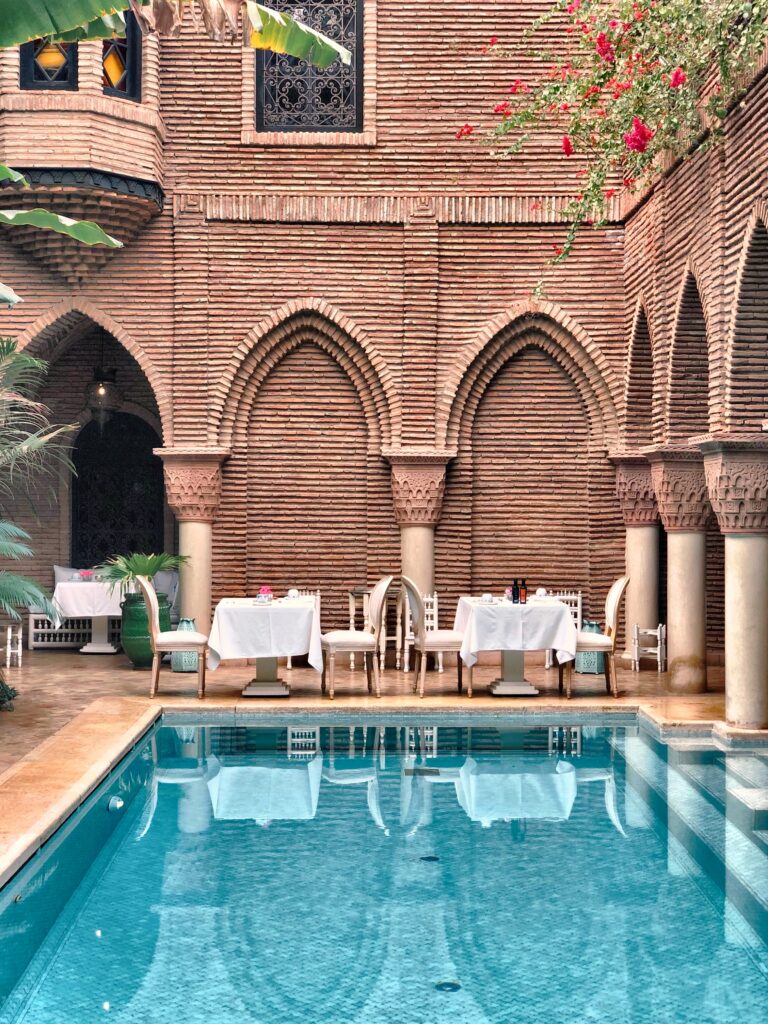
Crafting Elegance Amidst Nature’s Embrace
As one wanders through the verdant expanse of the Agdal of Marrakesh, a symphony of architectural wonders unfolds, each structure weaving its own narrative of craftsmanship and cultural splendor. In this section, we delve into the intricacies of the Agdal’s architectural tapestry, where regal palaces, pavilions, and fortifications stand as testaments to Morocco’s enduring commitment to architectural grandeur.
- 2.1 Almohad Palaces: The Almohad dynasty bequeathed the Agdal with grand palaces adorned with intricate tilework, geometric designs, and expansive courtyards. These palaces, such as jewels in the landscape, epitomize the Almohad commitment to architectural excellence, marrying form and function in a regal dance.
- 2.2 Kasbah-Style Fortifications: Surrounding the Agdal are Kasbah-style fortifications, a manifestation of Morocco’s strategic approach to defense and aesthetics. Towers and gateways punctuate the landscape, combining functional defensive structures with ornate embellishments. The Kasbah fortifications create a visual spectacle while safeguarding the cultural riches within.
- 2.3 Pavilion of the Twelve Columns: At the heart of the Agdal lies the Pavilion of the Twelve Columns, an architectural gem that captures the essence of Moroccan design. Its central dome, supported by twelve slender columns, creates an open and airy space. This pavilion serves both practical and aesthetic purposes, providing shade and a respite for those immersed in the landscape.
- 2.4 El Badi Palace: Adjacent to the Agdal, the El Badi Palace stands as a monumental achievement of Saadian architecture. Its expansive courtyards, sunken gardens, and intricately decorated pavilions showcase the mastery of Moroccan craftsmen. Zellige tilework, stucco carvings, and architectural nuances make El Badi a testament to Saadian opulence.
- 2.5 Water Features and Irrigation Systems: Integral to the Agdal’s architectural brilliance are its sophisticated water features and irrigation systems. Channels, aqueducts, and reservoirs, meticulously designed to harness water from the Atlas Mountains, not only sustain the gardens but also add an aesthetic dimension to the landscape. The engineering prowess behind these systems is a tribute to Morocco’s historical ingenuity.
- 2.6 Saadian Tombs: While not directly within the Agdal, the Saadian Tombs stand as an extension of its architectural marvels. Discovered in the 20th century, these tombs feature intricate tilework, marble carvings, and ornate mausoleums. The Saadian Tombs provide a glimpse into the continuation of architectural styles beyond the Agdal’s immediate boundaries.
- 2.7 Preservation Efforts: Modern preservation efforts aim to safeguard the Agdal’s architectural treasures. Restoration initiatives ensure that the structures maintain their authenticity while withstanding the tests of time. These efforts bridge the past with the present, allowing visitors to marvel at the same architectural wonders that graced the landscape centuries ago.
- 2.8 Visitor Experience: Exploring the architectural wonders within the Agdal offers visitors a sensory journey through Morocco’s cultural history. The interplay of geometric patterns, serene courtyards, and the natural beauty of the landscape creates an immersive experience. Each architectural element narrates a story of craftsmanship, cultural exchange, and the enduring allure of Morocco’s historical legacy.
- 2.9 Environmental Integration: Crucial to the Agdal’s architectural design is its seamless integration with the natural surroundings. Structures are strategically positioned to maximize views of the gardens and mountains. This intentional harmony between architecture and environment exemplifies the cultural philosophy embedded in the landscape.
In conclusion, the Agdal’s architectural marvels are not just structures; they are chapters in Morocco’s architectural narrative. From the grandeur of palaces to the functional beauty of fortifications, each element contributes to the visual symphony of the Agdal, where the craftsmanship of the past continues to captivate the present.
Section 3: Cultural Significance and Rituals:
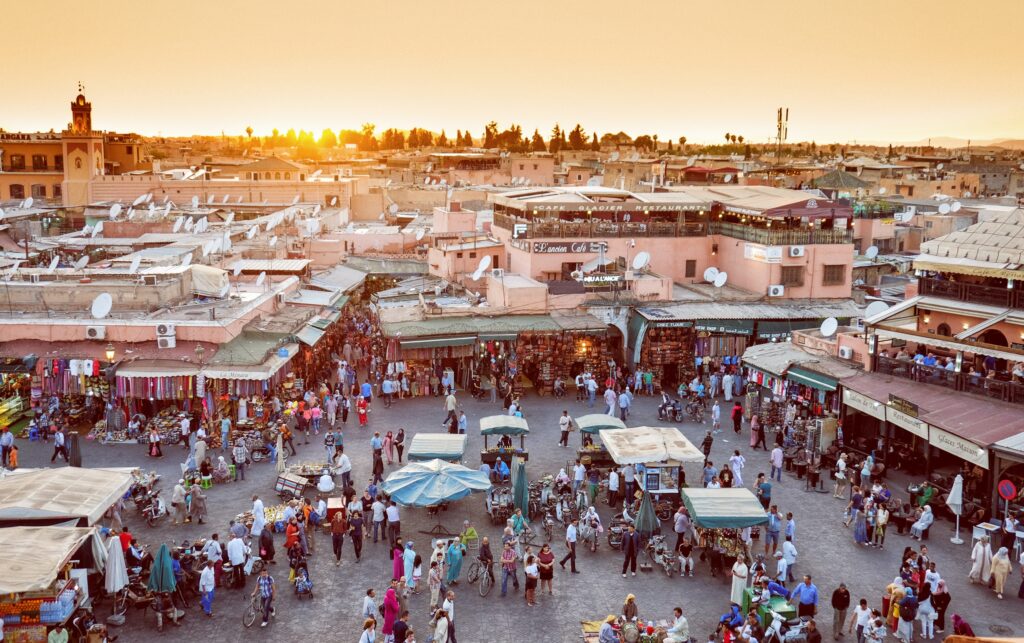
Weaving Tradition into the Fabric of the Agdal
Beyond the stone walls and verdant gardens, the Agdal of Marrakesh breathes life through cultural significance and rituals that echo through the corridors of time. In this section, we explore the profound connections between the landscape and the people, delving into ceremonial practices, spiritual observances, and communal celebrations that have shaped the Agdal’s identity.
- 3.1 Ceremonial Processions: The Agdal has been a silent witness to ceremonial processions that traverse its paths. Adorned in regal attire, rulers and dignitaries have walked the landscape in grand processions, symbolizing the harmony between earthly power and divine influence. The Agdal’s vastness provides a majestic backdrop for these ceremonials, linking rulership with the natural order.
- 3.2 Religious Observances: Imbued with a sacred aura, the Agdal serves as a sanctuary for religious observances. Prayer, meditation, and gatherings within its confines create an atmosphere of spiritual communion. The landscape becomes a conduit for connecting with the divine, where the beauty of nature harmonizes with the essence of faith.
- 3.3 Royal Celebrations: Commemorating significant events in the lives of rulers, the Agdal has been a stage for royal celebrations. Music, dance, and performances transform the landscape into a vibrant tapestry of color and sound. These celebrations not only honor historical milestones but also infuse the Agdal with the joyous energy of communal gatherings.
- 3.4 Harvest Rituals: Rooted in its agricultural heritage, the Agdal is a venue for harvest rituals and celebrations. As the fruits of the orchards and the yield from the gardens are abundant, communal festivities express gratitude for the land’s fertility. Harvest rituals underscore the symbiotic relationship between the people, the land, and the agricultural traditions that endure.
- 3.5 Traditional Festivals: The Agdal is an integral part of traditional festivals that celebrate Moroccan culture. These festivals incorporate music, dance, and local crafts, transforming the landscape into a vibrant showcase of the nation’s artistic heritage. The Agdal becomes a living canvas, reflecting the dynamic and diverse cultural expressions of the Moroccan people.
- 3.6 Water Rituals: Water, as a symbol of life and purity, holds profound cultural significance within the Agdal. The intricate irrigation systems and water features become focal points for rituals symbolizing renewal and the cyclical nature of existence. Water, carefully channeled through the landscape, becomes a metaphor for the perpetual flow of cultural traditions.
- 3.7 Seasonal Observances: The changing seasons bring about unique cultural observances within the Agdal. From spring blossoms to the bountiful fruits of summer and the contemplative atmosphere of winter, each season is marked by specific rituals that align with the rhythm of nature. These seasonal observances emphasize the interconnectedness of cultural practices with the agricultural cycles.
- 3.8 Preservation of Traditions: In contemporary times, efforts to preserve and promote traditional rituals within the Agdal are paramount. Cultural events and educational programs are organized to ensure that the rituals of the past continue to thrive, fostering a sense of continuity and connection to Morocco’s cultural heritage.
- 3.9 Community Engagement: The Agdal’s cultural significance is not static; it evolves through community engagement. Local residents actively participate in preserving rituals and passing down cultural practices to younger generations. This intergenerational transfer of knowledge reinforces the Agdal’s role as a living repository of Moroccan cultural traditions.
In conclusion, the Agdal of Marrakesh stands not only as a historical landscape but as a living canvas where cultural significance and rituals weave seamlessly into the fabric of Morocco’s rich heritage. The ceremonies, observances, and celebrations within its embrace affirm the Agdal’s role as a timeless space where tradition is nurtured and cultural identity is celebrated.
Section 4: Environmental Harmony:

Sustaining Nature’s Symphony in the Agdal
Amidst the grandeur of architecture and the cultural tapestry of rituals, the Agdal of Marrakesh reveals another dimension of its splendor—environmental harmony. In this section, we explore how the landscape of the Agdal is not just a stage for human endeavors but a testament to the delicate balance between human interaction and the natural world.
- 4.1 Agricultural Integration: Central to the environmental harmony within the Agdal is the seamless integration of agriculture into the landscape. Orchards bearing citrus fruits, olive groves, and vegetable gardens coexist with ornamental elements, creating a tapestry where practical agriculture and aesthetic beauty intertwine.
- 4.2 Water Management Systems: The Agdal’s sophisticated water management systems showcase an understanding of the preciousness of this resource in a semi-arid environment. Intricate channels, aqueducts, and reservoirs efficiently capture and distribute water from the nearby Atlas Mountains, ensuring the longevity of the gardens and preserving the delicate ecological balance.
- 4.3 Biodiversity and Flora: The Agdal serves as a sanctuary for biodiversity, housing a diverse array of plant species. From indigenous flora to carefully curated ornamental plants, the landscape supports a rich tapestry of life. This intentional cultivation of biodiversity contributes to the resilience of the ecosystem and enhances the overall environmental quality of the Agdal.
- 4.4 Natural Shade and Microclimates: The strategic placement of pavilions, trees, and architectural structures creates natural shade and microclimates within the Agdal. This not only enhances the visitor experience but also demonstrates an awareness of the importance of mitigating extreme temperatures. The cooling effect of shaded areas contributes to the overall comfort of the environment.
- 4.5 Erosion Prevention: The Agdal’s topography incorporates measures to prevent soil erosion, ensuring the preservation of the landscape’s integrity. Terraced gardens and carefully constructed pathways act as protective measures against erosion caused by both natural elements and human interaction. This proactive approach safeguards the Agdal’s unique features.
- 4.6 Sustainable Agricultural Practices: The agricultural practices within the Agdal reflect a commitment to sustainability. Traditional farming methods, such as organic cultivation and minimal use of chemical inputs, contribute to the health of the soil and promote long-term ecological balance. The integration of sustainable agriculture aligns with the principles of environmental conservation.
- 4.7 Adaptation to Climate Variability: The Agdal’s design demonstrates an inherent understanding of climate variability. The landscape’s adaptability to seasonal changes, from the scorching heat of summer to the cooler temperatures of winter, reflects a harmonious coexistence with the natural climate patterns of the region.
- 4.8 Educational Initiatives: Modern initiatives within the Agdal include educational programs that highlight the importance of environmental harmony. Visitors and local communities engage in activities that foster an appreciation for the interconnectedness of cultural heritage and ecological sustainability. These initiatives aim to inspire a sense of responsibility toward the environment.
- 4.9 Balancing Conservation and Tourism: As a UNESCO World Heritage site, the Agdal faces the delicate task of balancing conservation with the demands of tourism. Sustainable tourism practices, guided tours, and visitor regulations are implemented to minimize the environmental impact, ensuring that the Agdal’s ecological harmony remains intact for future generations.
In conclusion, the Agdal of Marrakesh stands as a remarkable example of environmental harmony, where the preservation of cultural heritage goes hand in hand with sustainable practices. This intricate dance between human culture and the natural world is a testament to the enduring wisdom embedded in the landscape, fostering a legacy of ecological stewardship in the heart of Morocco.
Section 5: UNESCO Recognition and Preservation Efforts:
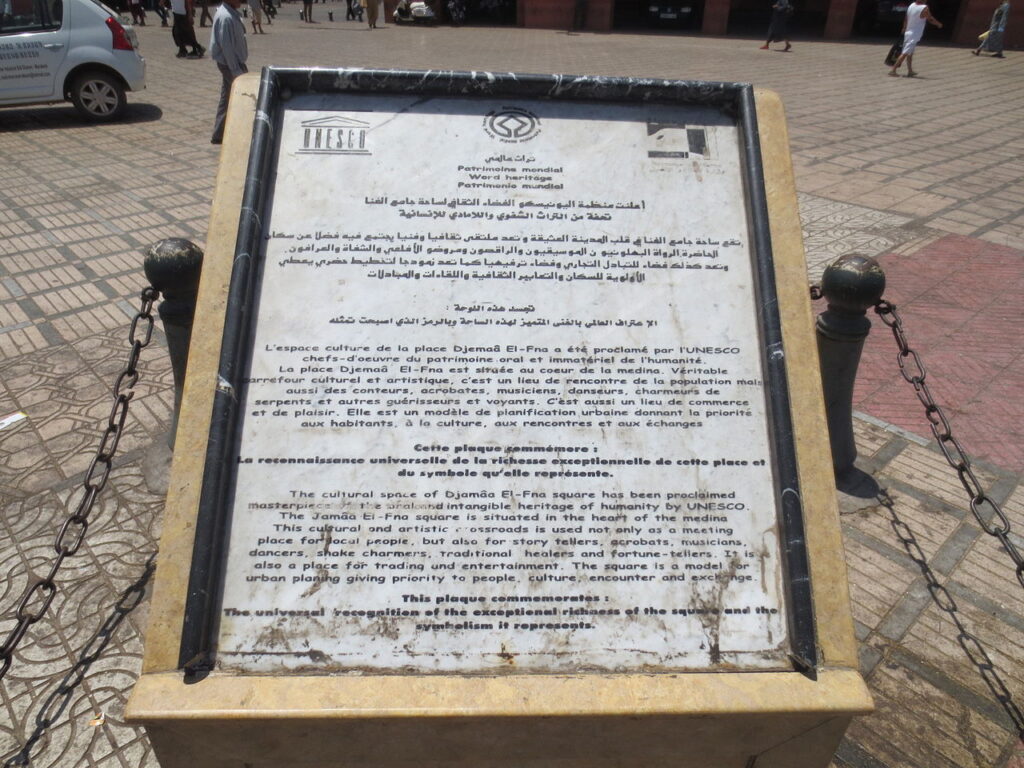
Safeguarding the Agdal’s Legacy
The Agdal of Marrakesh, with its cultural richness and historical significance, received the prestigious embrace of UNESCO in 2011. This section delves into the UNESCO recognition and the ongoing preservation efforts that ensure the Agdal’s timeless legacy is protected for future generations.
- 5.1 UNESCO World Heritage Status: In 2011, the Agdal was bestowed with the coveted title of UNESCO World Heritage site. This global acknowledgment affirmed the universal value of the Agdal as a cultural landscape that transcends national boundaries. The inscription recognized the Agdal’s outstanding cultural and natural significance, placing it among the world’s most revered heritage sites.
- 5.2 Criteria for UNESCO Recognition: The UNESCO recognition was not arbitrary; it was based on specific criteria that underline the exceptional qualities of the Agdal. These criteria include the landscape’s representation of human creative genius, its interchange of values, its testimony to cultural traditions, and its harmonious integration with the natural environment.
- 5.3 Importance of Recognition: UNESCO recognition elevated the Agdal to a global platform, bringing attention to its architectural marvels, cultural significance, and environmental harmony. The acknowledgment reinforced Morocco’s commitment to preserving its cultural heritage and contributed to international awareness of the unique tapestry woven within the Agdal’s bounds.
- 5.4 Preservation Initiatives: The UNESCO recognition spurred heightened preservation initiatives to safeguard the Agdal’s integrity. These efforts encompass comprehensive conservation plans, restoration projects, and ongoing maintenance. Preservation experts, architects, and environmentalists collaborate to ensure that the Agdal retains its authenticity while withstanding the tests of time.
- 5.5 Restoration of Architectural Elements: Central to preservation efforts is the meticulous restoration of architectural elements within the Agdal. Palaces, pavilions, and fortifications undergo careful restoration to revive their original splendor. This process involves utilizing traditional building techniques and materials, respecting the historical authenticity of each structure.
- 5.6 Conservation of Gardens and Biodiversity: The preservation of the Agdal extends beyond architecture to the conservation of its gardens and biodiversity. Sustainable landscaping practices, ecological monitoring, and measures to protect plant species contribute to the overall health of the landscape. These conservation efforts align with UNESCO’s emphasis on the interconnectedness of cultural and natural heritage.
- 5.7 Cultural Education and Awareness: Preservation initiatives include cultural education programs aimed at raising awareness among local communities, visitors, and stakeholders. Educational activities, guided tours, and interpretative materials foster a deeper appreciation for the Agdal’s cultural significance. This emphasis on cultural education ensures that the community becomes active stewards of their heritage.
- 5.8 Sustainable Tourism Practices: UNESCO recognition necessitates the implementation of sustainable tourism practices within the Agdal. Visitor management strategies, responsible tourism guidelines, and restrictions on potentially damaging activities help strike a balance between opening the site to the public and preserving its delicate environment.
- 5.9 Community Involvement and Empowerment: Preservation efforts actively involve local communities, recognizing their role as custodians of the Agdal’s heritage. Community engagement programs empower residents to participate in preservation activities, instilling a sense of pride and responsibility. This collaborative approach ensures that preservation is a shared endeavor.
In conclusion, the UNESCO recognition and ongoing preservation efforts stand as pillars supporting the Agdal’s enduring legacy. The landscape’s inscription on the World Heritage list symbolizes a commitment to global heritage preservation and underscores the importance of a collective dedication to safeguarding the Agdal for generations yet to come.
Section 6: Visitor Experience and Education:
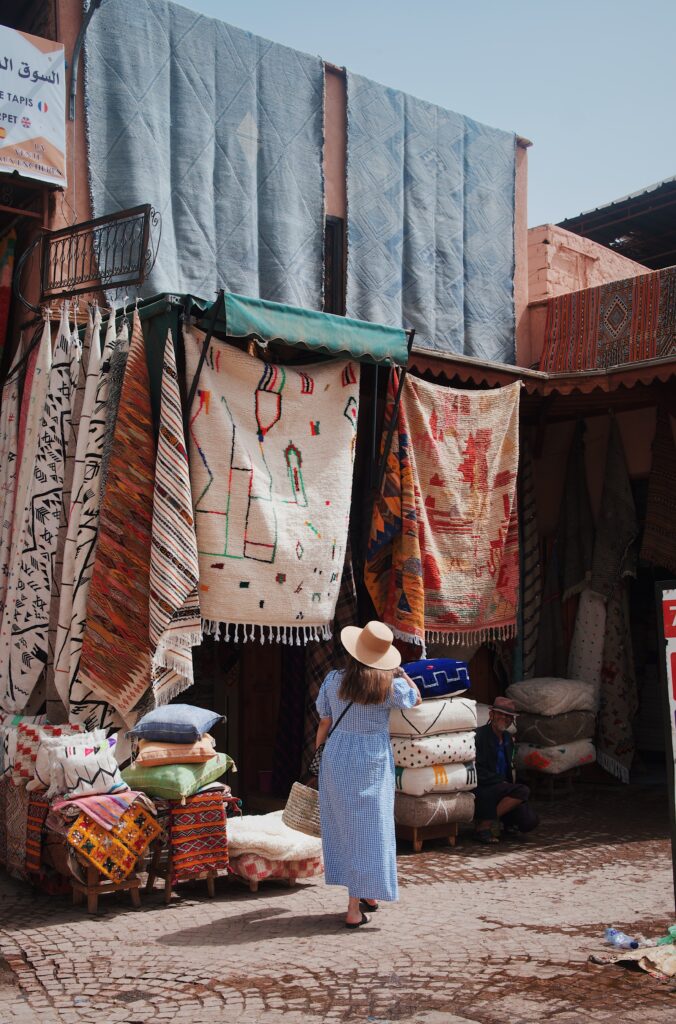
Immersing in the Agdal’s Cultural Tapestry
The Agdal of Marrakesh beckons visitors into a realm where history, culture, and nature converge. This section explores the immersive visitor experience within the Agdal and the educational initiatives that enhance understanding, fostering a profound connection with Morocco’s rich heritage.
- 6.1 Architectural Marvels: The visitor experience within the Agdal begins with a visual feast of architectural marvels. Grand palaces, pavilions, and fortifications unfold before the eyes, each structure revealing a chapter of Morocco’s dynastic history. Guided tours and interpretative materials provide insights into the architectural ingenuity that defines the Agdal’s landscape.
- 6.2 Gardens and Scenic Beauty: Visitors are enveloped in the tranquil beauty of gardens meticulously designed within the Agdal. Ornamental flora, water features, and expansive views of the Atlas Mountains create a serene atmosphere. The carefully curated landscapes serve as a canvas, inviting contemplation and providing a peaceful escape from the bustle of daily life.
- 6.3 Cultural Ceremonies and Celebrations: The Agdal comes alive during cultural ceremonies and celebrations. Visitors may witness traditional processions, musical performances, and festive events that evoke the vibrancy of Morocco’s cultural heritage. Participation in these celebrations allows visitors to feel the pulse of the Agdal’s living traditions.
- 6.4 Spiritual Retreat and Contemplation: For those seeking spiritual connection, the Agdal offers spaces for retreat and contemplation. Quiet corners, shaded pavilions, and open courtyards provide sanctuaries for meditation and reflection. The landscape’s spiritual significance becomes palpable, inviting visitors to experience a sense of tranquility and connection with the divine.
- 6.5 Educational Programs: Educational programs within the Agdal play a crucial role in enriching the visitor experience. Guided tours led by knowledgeable interpreters provide historical context, architectural insights, and cultural narratives. Interactive exhibits and multimedia presentations further enhance understanding, offering a comprehensive exploration of the Agdal’s significance.
- 6.6 Cultural Workshops and Demonstrations: To deepen engagement, cultural workshops and demonstrations offer hands-on experiences. Visitors may participate in traditional crafts, learn about Moroccan cuisine, or engage in activities that showcase the living heritage of the Agdal. These interactive sessions contribute to a holistic understanding of the culture embedded in the landscape.
- 6.7 Environmental Awareness: The visitor experience is intertwined with a heightened awareness of environmental conservation. Interpretative materials and guided discussions shed light on the Agdal’s sustainable practices, water management systems, and efforts to balance tourism with ecological preservation. Visitors are encouraged to become stewards of the environment.
- 6.8 Preservation Dialogues: Dialogues on preservation and heritage conservation are integral to the visitor experience. Interpretive signage and engagement with preservation experts create a dialogue on the challenges and successes of safeguarding the Agdal. Visitors gain insights into ongoing conservation efforts and the importance of collective responsibility.
- 6.9 Community Engagement Opportunities: Visitors have opportunities for community engagement, interacting with local residents and participating in community-led initiatives. This engagement fosters a sense of connection to the Agdal’s living heritage, emphasizing the collaborative efforts required to preserve its cultural significance.
In conclusion, the visitor experience within the Agdal transcends mere observation; it is an immersive journey through Morocco’s cultural tapestry. Educational initiatives enhance this experience, ensuring that visitors not only witness the Agdal’s splendor but also forge a meaningful connection with the history, culture, and environmental ethos that define this extraordinary landscape.
Section 7: Challenges and Future Prospects:

Navigating the Path Forward for the Agdal
While the Agdal of Marrakesh stands as a testament to Morocco’s cultural heritage, it faces challenges that require thoughtful navigation for a sustainable and vibrant future. This section explores the current challenges and envisions future prospects to ensure the Agdal continues to thrive as a living legacy.
- 7.1 Tourism Pressures: The increasing popularity of the Agdal as a tourist destination brings the challenge of managing visitor pressures. Striking a balance between welcoming tourists and preserving the delicate environment requires strategic planning, sustainable tourism practices, and the implementation of visitor guidelines.
- 7.2 Conservation and Restoration: Ongoing conservation and restoration efforts must address the preservation needs of the Agdal’s architectural elements, gardens, and biodiversity. Adequate funding, expertise, and collaboration with preservation organizations are essential to ensure that restoration projects align with international conservation standards.
- 7.3 Climate Change Impact: The impact of climate change poses a threat to the Agdal’s delicate ecological balance. Changes in temperature, precipitation patterns, and extreme weather events may affect the landscape’s sustainability. Implementing climate-resilient strategies and monitoring environmental changes become imperative for long-term preservation.
- 7.4 Community Engagement: The active involvement of local communities is crucial for the Agdal’s sustainable future. Empowering residents to be stewards of their heritage fosters a sense of ownership and responsibility. Community-led initiatives, educational programs, and collaborative decision-making can strengthen the Agdal’s resilience.
- 7.5 Balancing Modernization: As surrounding areas undergo modernization, there is a need to balance development with the preservation of the Agdal’s cultural and natural integrity. Urban planning that respects the historical context, zoning regulations, and sustainable development practices can contribute to this delicate balance.
- 7.6 Educational Outreach: Enhancing educational outreach initiatives can deepen public awareness about the Agdal’s significance. Outreach programs targeting schools, universities, and the wider public can instill a sense of pride and responsibility, nurturing a culture of respect for cultural heritage and environmental sustainability.
- 7.7 Technological Integration: Embracing technological advancements can aid in the conservation and promotion of the Agdal. Digital tools, virtual tours, and interactive exhibits can enhance the visitor experience while minimizing physical impact. Remote monitoring technologies can also assist in environmental conservation efforts.
- 7.8 International Collaboration: Collaborating with international organizations, heritage experts, and environmental agencies can provide valuable support. Exchange of knowledge, best practices, and financial assistance can bolster preservation efforts and ensure that the Agdal remains a globally recognized cultural landscape.
- 7.9 Sustainable Funding Models: Developing sustainable funding models is critical for the Agdal’s ongoing maintenance and preservation. Public-private partnerships, philanthropic contributions, and innovative funding strategies can secure the financial resources needed to address immediate challenges and plan for the landscape’s long-term sustainability.
In conclusion, addressing the challenges faced by the Agdal requires a holistic and collaborative approach. By embracing sustainability, community engagement, technological innovations, and international cooperation, the Agdal can navigate its path forward, ensuring that it continues to inspire awe and reverence for generations to come.
Conclusion:
A Tapestry of Timeless Heritage in the Agdal of Marrakesh
In the heart of Morocco lies the Agdal of Marrakesh, a living testament to the rich tapestry of the nation’s cultural heritage. Spanning centuries, this landscape encapsulates the spirit of Morocco’s dynasties, the ingenuity of its architects, and the harmony between nature and human creativity. As we conclude our exploration of the Agdal, several key themes emerge, weaving together the threads of its timeless narrative.
The Agdal stands as a beacon of architectural brilliance, where grand palaces, pavilions, and fortifications narrate the story of Morocco’s dynastic history. Each structure, adorned with intricate tilework, geometric designs, and symbolic motifs, reflects the cultural fusion that defines Morocco’s identity. The Agdal is not merely a collection of buildings; it is a living canvas that depicts the evolution of Moroccan civilization.
Beyond its architectural splendor, the Agdal unfolds as a sanctuary of environmental harmony. Meticulously designed gardens, sustainable agricultural practices, and sophisticated water management systems showcase Morocco’s deep connection to the land. The Agdal’s adaptation to climate variability and its commitment to biodiversity conservation underscore a holistic approach that intertwines culture with nature.
Cultural significance and rituals breathe life into the Agdal, where ceremonial processions, religious observances, and traditional festivals echo through time. The landscape becomes a stage for royal celebrations and communal gatherings, fostering a sense of unity and continuity. The Agdal’s role in preserving and promoting cultural traditions is not static; it evolves through community engagement, education, and the transmission of knowledge across generations.
The Agdal’s recognition as a UNESCO World Heritage site in 2011 marked a pivotal moment in its history. This acknowledgment elevated the landscape to a global platform, emphasizing its universal value and the collective responsibility to preserve it. Preservation efforts, including conservation, restoration, and sustainable tourism practices, are integral to ensuring that the Agdal’s legacy endures.
Challenges and future prospects beckon us to navigate a path that safeguards the Agdal’s cultural and natural integrity. From managing tourism pressures to addressing climate change impacts, the journey ahead requires collaboration, innovation, and a steadfast commitment to sustainable practices. Balancing modernization with heritage preservation, engaging local communities, and embracing technological advancements will be essential in shaping the Agdal’s sustainable future.
As we reflect on the Agdal of Marrakesh, we recognize not just a landscape but a living heritage that invites us to explore, learn, and appreciate the interwoven threads of Morocco’s past and present. The Agdal’s allure lies not only in its architectural grandeur or environmental splendor but in its ability to evoke a profound connection to the essence of Morocco—a timeless journey through the cultural landscapes of a nation.

